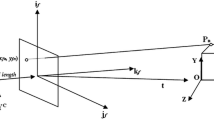Abstract
This paper deals with the problem of locating a rigid object and estimating its motion in three dimensions. This involves determining the position and orientation of the object at each instant when an image is captured by a camera, and recovering the motion of the object between consecutive frames.
In the implementation scheme used here, a sequence of camera images, digitized at the sample instants, is used as the initial input data. Measurements are made of the locations of certain features (e.g., maximum curvature points of an image contour, corners, edges, etc.) on the 2-D images. To measure the feature locations a matching algorithm is used, which produces correspondences between the features in the image and the object.
Using the measured feature locations on the image, an algorithm is developed to solve the location and motion problem. The algorithm is an extended Kalman filter modeled for this application.
Similar content being viewed by others
References
S. Ullman, “Analysis of visual motion by biological and computer systems,” Computer 14:57–69, August 1981.
H.H. Nagel, “Overview on image sequence analysis.” In T.S. Huang (ed.), Image Sequence Processing and Dynamic Scence Analysis. Springer-Verlag: Berlin/Heidelberg, pp. 2–38, 1983.
K.H. Hohne and B. Bohm, “Processing and analysis of radiographic image sequence.” In T.S. Huang (ed.), Image Sequence Processing and Dynamic Scene Analysis. Springer-Verlag: Berlin/Heidelberg, pp. 603–623, 1983.
Y. Yasumoto and G. Medioni, “Experiments in estimation of 3-D motion parameters from a sequence of image frames,” Proc. IEEE Conf. Computer Vision Pattern Recognition, San Francisco, pp. 89–94, 1985.
R.Y. Tsai and T.S. Huang, “Uniqueness and estimation of 3-D motion parameters of rigid objects with curved surface,” IEEE Trans. PAMI 6:13–27, January 1984.
H.C. Longuet-Higgins, “A computer algorithm for reconstructing a scene from two projections,” Nature 293:133–135, September 1981.
A.Z. Meri, “On monocular perspective of 3-D moving objects,” IEEE Trans. PAMI 2:582–583, November 1980.
H.H. Nagel, “On the derivation of 3-D rigid point configurations from image sequence,” Proc. IEEE Conf. Pattern Recog. Image Processing, Dallas, pp. 103–108, August 1981.
T.S. Huang and J.Q. Fang, “Estimating 3-D motion parameters: Some experimental results,” Proc. 3rd Intern. Conf. Robot Vision and Sensory Controls, Cambridge, MA. pp. 229–231, November 1983.
J.Q. Fang and T.S. Huang, “Some experiments on estimating the 3-D motion parameters of a rigid body from two consecutive image frames,” IEEE Trans. PAMI 6:545–554, September 1984.
J. O'Rourke, “Motion detection using Hough techniques,” Proc. IEEE Conf. Pattern Recognition Image Processing. Dallas, pp. 82–87, August 1981.
B.K.P. Horn and B.G. Schunck, “Determining optical flow,“ Arficial Intelligence 17:185–203, 1981.
B.G. Schunck, “Image flow: Fundamentals and future research,” Proc. IEEE Conf. Computer Vision Pattern Recognition, San Francisco, 560–571, 1985.
G. Avid, “Determining 3-D motion and structure from optical flow generated by several moving objects,” IEEE Trans. PAMI 6:384–401, July 1985.
S. Negahdaripour and B.K.P. Horn, “Determining 3-D motion of planar objects from image brightness patterns,” MIT Artificial Intelligence Laboratory, 1985.
G. Avid, “Inherent ambiguities in recovering 3-D motion and structure from a noisy flow field,” Proc. IEEE Conf. Computer Vision Pattern Recognition, San Francisco, pp. 70–77, 1985.
K. Kanatani, “Structure and motion from optical flow under perspective projection,” submitted to Computer Vision, Graphics, and Image Processing, 1986.
T.J. Broida and R. Chellappa, “Estimation of object motion parameters from noise images, IEEE Trans. PAMI 8:90–99, January 1986.
O.D. Faugeras, N. Ayache, and B. Faverjon, “Building visual maps by combining noisy stereo measurements,” Proc. IEEE Conf. Robotics and Automation, San Francisco, pp. 1433–1438, 1986.
D.B. Gennery, “Tracking known three-dimensional objects,” AAAI-82:13–17, 1982.
J. Stuelpnagel, “On the parameterization of the three-dimensional rotation group,” SIAM Review 6(4):422–430, October 1964.
R. Paul, Robot Manipulators: Mathematics: Programming and Control, MIT Press: Cambridge, MA. 1981.
J. Wittenburg, Dynamics of Systems of Rigid Bodys, B.G. Teubner: Stuttgart, 1977.
R.Y. Tsai, “An efficient and accurate camera calibration technique for 3-D machine vision,” Proc. IEEE Conf. Comput. Vision Pattern Recognition, Miami, pp. 364–374, 1986.
P.S. Maybeck, Stochastic Models, Estimation, and Control. Academic Press: San Diego, CA, vol. 1, 1979, vol. 2 1982.
B.D.O. Anderson and J.B. Moore, Optimal Filtering. Prentice-Hall: Englewood Cliffs, NJ, 1977.
A.V. Balakrishnan, Kalman Filtering Theory, Optimization Sottware: New York, 1984.
P.J. Besl and R.C. Rain. “Three Dimensional Object Recognition,” ACM Computing Surveys, 17(1): 1985.
J.J. Wu, An Intensity Image System for 3D Object Recognition, Localization, and Motion Recovery. Ph.D. dessertation, Department of Electrical Engineering, University of Alberta, 1988.
J. Levin, “Mathematical Models for Determining the Intersections of Quadratic Surfaces,” Computer Vision, Graphic, and Image Processing, 11:73–87, 1979.
Additional information
Department of Electrical Engineering and Alberta Center for Machine Intelligence and Robotics, University of Alberta
Rights and permissions
About this article
Cite this article
Wu, J.J., Rink, R.E., Caelli, T.M. et al. Recovery of the 3-D location and motion of a rigid object through camera image (An Extended Kalman Filter Approach). Int J Comput Vision 2, 373–394 (1989). https://doi.org/10.1007/BF00133556
Issue Date:
DOI: https://doi.org/10.1007/BF00133556




